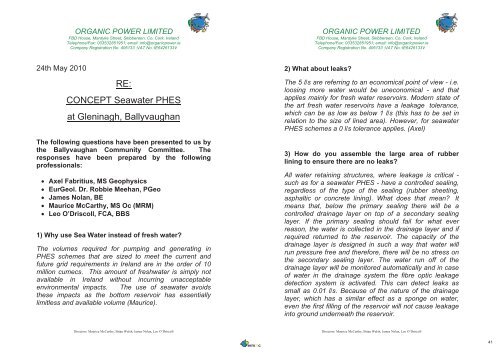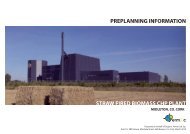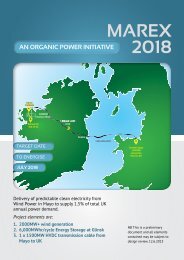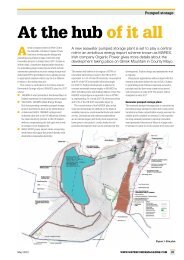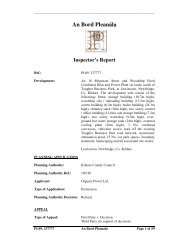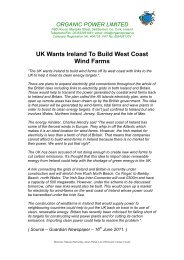PRE INVESTIGATION CONCEPT INFORMATION - Organic Power
PRE INVESTIGATION CONCEPT INFORMATION - Organic Power
PRE INVESTIGATION CONCEPT INFORMATION - Organic Power
- No tags were found...
You also want an ePaper? Increase the reach of your titles
YUMPU automatically turns print PDFs into web optimized ePapers that Google loves.
ORGANIC POWER LIMITEDFBD House, Mardyke Street, Skibbereen, Co. Cork, IrelandTelephone/Fax: 003532851951; email :info@organicpower.ieCompany Registration No. 406133 ;VAT No.:IE6426133VORGANIC POWER LIMITEDFBD House, Mardyke Street, Skibbereen, Co. Cork, IrelandTelephone/Fax: 003532851951; email: info@organicpower.ieCompany Registration No. 406133 ;VAT No.:IE6426133V24th May 2010RE:<strong>CONCEPT</strong> Seawater PHESat Gleninagh, BallyvaughanThe following questions have been presented to us bythe Ballyvaughan Community Committee. Theresponses have been prepared by the followingprofessionals: Axel Fabritius, MS Geophysics EurGeol. Dr. Robbie Meehan, PGeo James Nolan, BE Maurice McCarthy, MS Oc (MRM) Leo O’Driscoll, FCA, BBS1) Why use Sea Water instead of fresh water?The volumes required for pumping and generating inPHES schemes that are sized to meet the current andfuture grid requirements in Ireland are in the order of 10million cumecs. This amount of freshwater is simply notavailable in Ireland without incurring unacceptableenvironmental impacts. The use of seawater avoidsthese impacts as the bottom reservoir has essentiallylimitless and available volume (Maurice).2) What about leaks?The 5 l/s are referring to an economical point of view - i.e.loosing more water would be uneconomical - and thatapplies mainly for fresh water reservoirs. Modern state ofthe art fresh water reservoirs have a leakage tolerance,which can be as low as below 1 l/s (this has to be set inrelation to the size of lined area). However, for seawaterPHES schemes a 0 l/s tolerance applies. (Axel)3) How do you assemble the large area of rubberlining to ensure there are no leaks?All water retaining structures, where leakage is critical -such as for a seawater PHES - have a controlled sealing,regardless of the type of the sealing (rubber sheeting,asphaltic or concrete lining). What does that mean? Itmeans that, below the primary sealing there will be acontrolled drainage layer on top of a secondary sealinglayer. If the primary sealing should fail for what everreason, the water is collected in the drainage layer and ifrequired returned to the reservoir. The capacity of thedrainage layer is designed in such a way that water willrun pressure free and therefore, there will be no stress onthe secondary sealing layer. The water run off of thedrainage layer will be monitored automatically and in caseof water in the drainage system the fibre optic leakagedetection system is activated. This can detect leaks assmall as 0.01 l/s. Because of the nature of the drainagelayer, which has a similar effect as a sponge on water,even the first filling of the reservoir will not cause leakageinto ground underneath the reservoir.Directors: Maurice McCarthy, Brian Walsh, James Nolan, Leo O’DriscollDirectors: Maurice McCarthy, Brian Walsh, James Nolan, Leo O’Driscoll41


